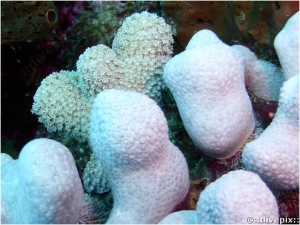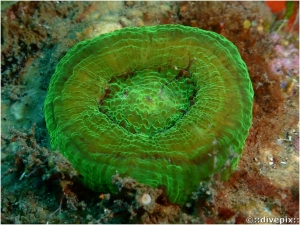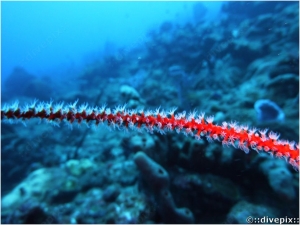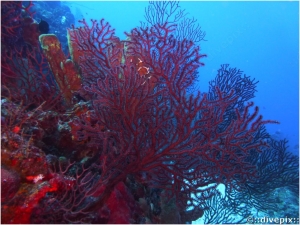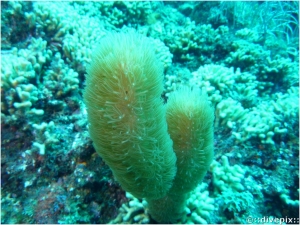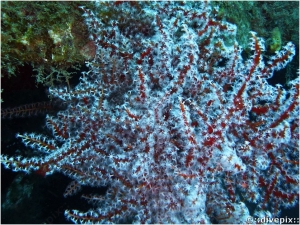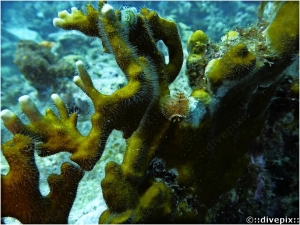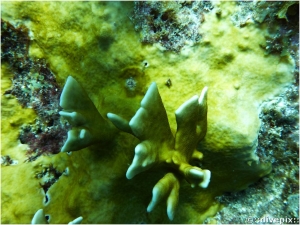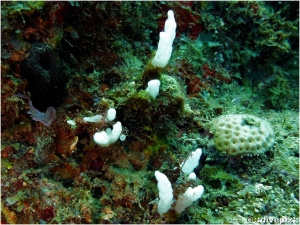




Eric H. Biass
Clubtip Finger Coral or Club Tipped Finger Coral
| Aspect: |
Colonies of thick light grey or brown short branches that are often club tipped. Branch diameter can range from two to three centimetres. Height is more difficult to determine as terrain configuration and neighbouring creatures may force branches to "creep". Variants: - One variant is known as Porites furcata (Branched Finger Coral); lighter in colour (almost white) tips tend to fork out (hence its name). - A second variant is know as Porites divarticata (Thin Finger Coral), is much slender and features much more prominent branches with a coloration that ranges from red-brown to ourtright purple. |
| Population: | Abundant |
| Notable feature: |
When retracted, polips les a smooth bone-like whitish surface. Polyps will grow back on the bare surface left by a broke branch. |
| Environment: | Usually on relatively horizontal sufaces, but can grown atop an older colony or coral boulder. |
| Behaviour: | - |
Elkhorn Coral
| Aspect: | As its names implies, each branch is reminiscent of the horn of an elk, however the entire coral more resembles a huge chanterelle mushroom, even sharing its similar yellow to orange colour. |
| Population: | Common. |
| Notable feature: | Its upper/internal suface bearing the coralite is a harder structure than one would at first expect. Periperal coralites tend to be lighter coloured and even white (see detailed images) |
| Environment: | Always appears to grow on a seemingly commanding position atop of a boulder or a rock in well swept areas, close to the surface.. |
| Behaviour: | - |
Artichoke Coral
| Aspect: | The polyp ressembles a thick-edged tea cup saucer and can sport a range of colours. A close look reveals a rough surface though. This species is regarded as solitary although the other two visually similar varieties (Artichoke and Atlantic Mushroom, q.v.) also grow in an isolated manner (as opposed to colonies). The central mouth slit is often visible in the centre of the usually convex disc centre. Tentacles extend at night as exemplified by the picture of a pale green and brown specimen (positions 3 and 4 below) photographed on the Franjack wreck at night. |
| Population: | Common. |
| Notable feature: | CAUTION: Although there are three distinct species of such small disc-shaped coral in the area - Artichoke Coral or Scolymia cubensis (seen here), Solitary Disc Coral or Scolymia wellsi (q.v.), and Atlantic Mushroom Coral or Scloymia lacera (q.v.) - which can only be differentiated with certainty by a microscopic observation of their corallite structure (and more particularly the shape of tip of their septa), the latter can be distinguished by its considerably rougher surfaces. Other visual cues that help telling an Artichoke Coral from a Solitary Disc Coral involve their central surfaces, which tend to be convex in the former and concave in the latter. |
| Environment: | Usually found against rock or boulder walls. |
| Behaviour: | Tentacles only extend at night. |
Devil's Sea Whip
| Aspect: | Although similar from a distance to Wire Coral (q.v.), which is a black coral, this octocoral's structure l is red or orange and bears typical eight-branched white polyps. |
| Population: | Common. |
| Notable feature: | Weighlessly winds its way into the open water. Readily distinguishes itself from the similar-looking Wire Coral (q.v.) by its eight-tentacle polyps. |
| Environment: | Sandy bottom. |
| Behaviour: | - |
Deepwater Sea Fan
| Aspect: | Large single-plane fan with random dichotomous branches which, given the depth at which they develop look black due to the disappearance of the red portion of the light spectrum, but surprisingly switch to bright red in the beam of a torch, revealing its true colour. |
| Population: | Common at depths of over 30 metres. |
| Notable feature: | Bare "polished wood-like" branches dramatically change into heavily overladen structures when polyps and their eight tentacles are extended (this indeed makes it an octocoral). |
| Environment: | Very often grow on the sides current-exposed rock walls |
| Behaviour: | Polyps extend during daytime when current exists. |
Corky Sea Finger
| Aspect: | Commonly grow as clusters of upright posts. Bare finger surface looks like plucked duck skin, but when the long polyps are fully extended the coral structure looks hairy. An encrusting variety also occurs, sporting identical polyps. |
| Population: | Common |
| Notable feature: | Seemingly disproportionately long and loose polyps give a "hairy" appearance. |
| Environment: | Usually found at around 10 to 15 metres on relatively flat surfaces, or on boulders for the encrusting variety |
| Behaviour: - |
Colorful Sea Rod
| Aspect: | Bushy formation of colonies of irregularly shaped and knotty red or bright orange branches from which a myriad white, lace-like polyps extend (Nodulifera, in the latin name, means knotty). Also known as "Finger Sea Fan". Calyces are entirely white down the coloured rind of the branch. |
| Population: | Not widespread. Traditionally put in the order of the Gorgonacea, that name is now replaced with "Alcyonacea" |
| Notable feature: | Unlike most other gorgonians, the several samples herewith displayed do not develop in a roughly single plane, but rathermore randomly into a bouquet. Yet they were photographed in two different and fairly distant spots. Tentacles deploy highly visible pinnules. |
| Environment: | Open, well exposed sites - in the case of Guadeloupe' West Coast, so far only seen on two wrecks, the Gustavia (40 metres ) and the Augustin Fresnel, 30 metres). |
| Behaviour: | - |
Branching Fire Coral
| Aspect: | A relatively short mass of randomly branching colonies that can take wide variety of shapes. Usually yellow brown, but also green. |
| Population: | Common |
| Notable feature: | Branches look like fingers. The entire structure is covered in a spectacularly dense array of translucent and hair-like stinging polyps. |
| Environment: | Usually atop boulders, at depths of around 10 metres or more. |
| Behaviour: | The barely visible hair-thin polyps can inflict very painful skin burns even through light conctact. |
Variable Boring Sponge
| Aspect: | White, almost translucent, thin-walled fingers. |
| Population: | Occasional |
| Notable feature: |
While most variable boring sponges in the Caribbean are described as being yellow and stouter, this rarer thin white variety appears to be the norm along Basse Terre's West Coast. Boring sponges are thus named because they exsude an acid from their base to bore an anchoring point in the substrate on which they settle. |
| Environment: | On coral boulders or rocky sand bottoms in sheltered areas. |
| Behaviour: | - |



